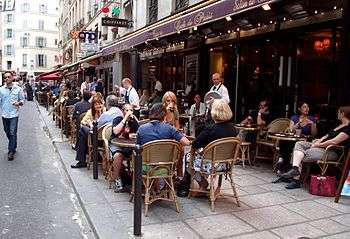Culinary tourism

Culinary tourism or food tourism is the exploration of food as the purpose of tourism.[2] It is now considered a vital component of the tourism experience.[3] Dining out is common among tourists and "food is believed to rank alongside climate, accommodation, and scenery" in importance to tourists.[3]
Overview
Culinary or food tourism is the pursuit of unique and memorable eating and drinking experiences, both near and far. Culinary tourism differs from agritourism in that culinary tourism is considered a subset of cultural tourism (cuisine is a manifestation of culture) whereas agritourism is considered a subset of rural tourism,[4] but culinary tourism and agritourism are inextricably linked, as the seeds of cuisine can be found in agriculture. Culinary/food tourism is not limited to gourmet food.[1]
While many cities, regions or countries are known for their food, culinary tourism is not limited by food culture. Every tourists eats at least three times a day, making food one of the fundamental economic drivers of tourism. Countries like Ireland, The Philippines, and Canada are making significant investment in culinary tourism development and are seeing results with visitor spending and over night stays rising as a result of food tourism promotion and product development.
Guided tours for food
The food tour formula varies from tour to tour and from operator to operator (of which there are many). Most, however, feature the following elements:
- They operate in major cities, generally but not always capital cities, that have substantial tourist numbers. Tours exist – amongst other places - in London, Paris,[5][6] Rome, Istanbul, New York City, Lisbon, Berlin, Madrid, Belfast, San Francisco, Copenhagen, Kuala Lumpur and Barcelona. The essential for operators is to find a city with a vibrant and interesting food culture. Street food may feature.
- There are wide variations in cost, however they are more expensive in the United States,[7] and less so in Asia.
- Tours are generally on foot. The distances traveled are never large – sometimes as in the Indian Food Tour of London,[8] they are focused on a few adjoining streets. Few tourists seem to want a cycle tour although one or two cycle tour companies are considering a food element.
- Tours typically last for a minimum three hours although many last longer. Many tours start around 11:00 am local time and continue well into the afternoon, making it the day's major attraction. Tours generally start and end at public transport hubs such as metro stations.
- Participant numbers vary but 12 to 16 is generally considered the upper limit.
- Tours rarely charge for small children who share food with parents/carers. Tours may not be necessarily fully compliant with wheelchair use – this will depend on the exact tour and the attitude of each location to disability.
- Tours take visitors to places they might otherwise not have seen, so they can shop and eat like locals rather than rely on tourist “traps”. Phrases such as “eat the city like a real Parisian/Berliner/Londoner/New Yorker” are often employed in food tour publicity.
- All tours are guided by local people. Many tour guides add their local knowledge as a bonus, perhaps recommending restaurants in other parts of the city.
- Tours are primarily about food. The format varies from company to company but will generally include visits to markets, bars, and cafés where those on the tour are invited to sample the wares. There is usually a shop visit to buy the sort of food that is difficult to source elsewhere. Tours may end up with a sit-down meal at a restaurant where there is usually the choice of beer, wine or soft drinks.
- Guides talk about food, often pointing those on the tour to shops they use. They may discuss how the sort of food they and their families eat differs from the food generally offered to tourists. They are unlikely to be kindly disposed to international fast food outlets.
- Guides generally add in material about the history of the area the tour is in. Most tours are close to, but not in, major tourist zones.
- Tours assume that participants eat almost anything and are not designed for special diets. However, most can accommodate vegetarians although vegan diets are rarely catered for – an exception is the Indian Food Tour (as many in India are vegan). The same warning applies to those looking for gluten-free etc.
- Many tour companies aim to create a sustainable tourism model over which they provide to their clients an experience that makes a positive impact on the local environment, society and economy by working only with local producers and/or family own establishments, and celebrating local traditions, all on foot, which means having a zero carbon footprint
References
- 1 2 Allen, Gary J.; Albala, Ken (2007-10-30). The Business of Food: Encyclopedia of the Food and Drink Industries. ABC-CLIO. pp. 112–. ISBN 9780313337253. Retrieved 12 March 2013.
- ↑ Long, Lucy (2004). Culinary Tourism. The University Press of Kentucky. p. 20. ISBN 9780813122922.
- 1 2 McKercher, Bob; Okumus, Fevzi and Okumus, Bendegul (2008). "Food Tourism as a Viable Market Segment: It's All How You Cook the Numbers!". Journal of Travel & Tourism Marketing. 25 (2): 137–148. doi:10.1080/10548400802402404.
- ↑ Wolf, Erik (2006). Culinary Tourism: The Hidden Harvest. Kendall/Hunt Publishing. ISBN 978-0-7575-2677-0.
- ↑ "Discover the Paris food scene like a true Parisian". deliciousmagazine.co.uk.
- ↑ "In Paris, 8 New Tours, From Art to Shopping". The New York Times. October 16, 2016.
- ↑ "Traveling to eat: Food tourism grows in USA". USA Today. February 19, 2007.
- ↑ "Indian Food Tour - East End London". Secret Food Tour.
8. Indian Food Tour - East End London